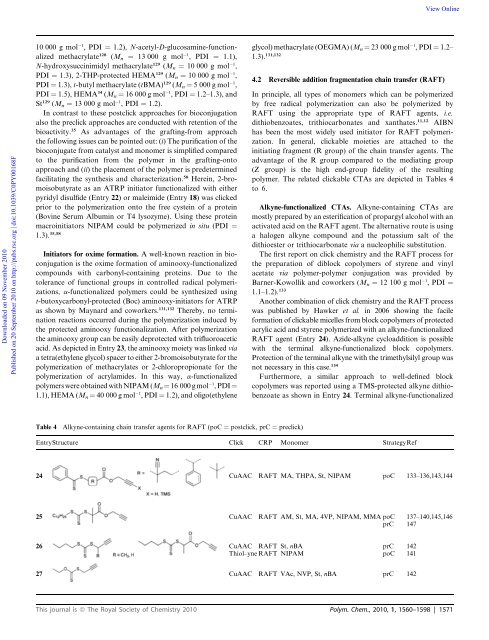Clickable initiators, monomers and polymers in controlled radical ...
Clickable initiators, monomers and polymers in controlled radical ...
Clickable initiators, monomers and polymers in controlled radical ...
Create successful ePaper yourself
Turn your PDF publications into a flip-book with our unique Google optimized e-Paper software.
View Onl<strong>in</strong>e<br />
Downloaded on 09 November 2010<br />
Published on 20 September 2010 on http://pubs.rsc.org | doi:10.1039/C0PY00168F<br />
10 000 g mol 1 , PDI ¼ 1.2), N-acetyl-D-glucosam<strong>in</strong>e-functionalized<br />
methacrylate 128 (M n ¼ 13 000 g mol 1 , PDI ¼ 1.1),<br />
N-hydroxysucc<strong>in</strong>imidyl methacrylate 129 (M n ¼ 10 000 g mol 1 ,<br />
PDI ¼ 1.3), 2-THP-protected HEMA 129 (M n ¼ 10 000 g mol 1 ,<br />
PDI ¼ 1.3), t-butyl methacrylate (tBMA) 129 (M n ¼ 5 000 g mol 1 ,<br />
PDI ¼ 1.5), HEMA 34 (M n ¼ 16 000 g mol 1 , PDI ¼ 1.2–1.3), <strong>and</strong><br />
St 129 (M n ¼ 13 000 g mol 1 , PDI ¼ 1.2).<br />
In contrast to these postclick approaches for bioconjugation<br />
also the preclick approaches are conducted with retention of the<br />
bioactivity. 35 As advantages of the graft<strong>in</strong>g-from approach<br />
the follow<strong>in</strong>g issues can be po<strong>in</strong>ted out: (i) The purification of the<br />
bioconjugate from catalyst <strong>and</strong> monomer is simplified compared<br />
to the purification from the polymer <strong>in</strong> the graft<strong>in</strong>g-onto<br />
approach <strong>and</strong> (ii) the placement of the polymer is predeterm<strong>in</strong>ed<br />
facilitat<strong>in</strong>g the synthesis <strong>and</strong> characterization. 58 Here<strong>in</strong>, 2-bromoisobutyrate<br />
as an ATRP <strong>in</strong>itiator functionalized with either<br />
pyridyl disulfide (Entry 22) or maleimide (Entry 18) was clicked<br />
prior to the polymerization onto the free cyste<strong>in</strong> of a prote<strong>in</strong><br />
(Bov<strong>in</strong>e Serum Album<strong>in</strong> or T4 lysozyme). Us<strong>in</strong>g these prote<strong>in</strong><br />
macro<strong><strong>in</strong>itiators</strong> NIPAM could be polymerized <strong>in</strong> situ (PDI ¼<br />
1.3). 35,58<br />
Initiators for oxime formation. A well-known reaction <strong>in</strong> bioconjugation<br />
is the oxime formation of am<strong>in</strong>ooxy-functionalized<br />
compounds with carbonyl-conta<strong>in</strong><strong>in</strong>g prote<strong>in</strong>s. Due to the<br />
tolerance of functional groups <strong>in</strong> <strong>controlled</strong> <strong>radical</strong> polymerizations,<br />
a-functionalized <strong>polymers</strong> could be synthesized us<strong>in</strong>g<br />
t-butoxycarbonyl-protected (Boc) am<strong>in</strong>ooxy-<strong><strong>in</strong>itiators</strong> for ATRP<br />
as shown by Maynard <strong>and</strong> coworkers. 131,132 Thereby, no term<strong>in</strong>ation<br />
reactions occurred dur<strong>in</strong>g the polymerization <strong>in</strong>duced by<br />
the protected am<strong>in</strong>ooxy functionalization. After polymerization<br />
the am<strong>in</strong>ooxy group can be easily deprotected with trifluoroacetic<br />
acid. As depicted <strong>in</strong> Entry 23, the am<strong>in</strong>ooxy moiety was l<strong>in</strong>ked via<br />
a tetra(ethylene glycol) spacer to either 2-bromoisobutyrate for the<br />
polymerization of methacrylates or 2-chloropropionate for the<br />
polymerization of acrylamides. In this way, a-functionalized<br />
<strong>polymers</strong> were obta<strong>in</strong>ed with NIPAM (M n ¼ 16 000 g mol 1 ,PDI¼<br />
1.1), HEMA (M n ¼ 40 000 g mol 1 ,PDI¼ 1.2), <strong>and</strong> oligo(ethylene<br />
glycol) methacrylate (OEGMA) (M n ¼ 23 000 g mol 1 ,PDI¼ 1.2–<br />
1.3). 131,132<br />
4.2 Reversible addition fragmentation cha<strong>in</strong> transfer (RAFT)<br />
In pr<strong>in</strong>ciple, all types of <strong>monomers</strong> which can be polymerized<br />
by free <strong>radical</strong> polymerization can also be polymerized by<br />
RAFT us<strong>in</strong>g the appropriate type of RAFT agents, i.e.<br />
dithiobenzoates, trithiocarbonates <strong>and</strong> xanthates. 11,12 AIBN<br />
has been the most widely used <strong>in</strong>itiator for RAFT polymerization.<br />
In general, clickable moieties are attached to the<br />
<strong>in</strong>itiat<strong>in</strong>g fragment (R group) of the cha<strong>in</strong> transfer agents. The<br />
advantage of the R group compared to the mediat<strong>in</strong>g group<br />
(Z group) is the high end-group fidelity of the result<strong>in</strong>g<br />
polymer. The related clickable CTAs are depicted <strong>in</strong> Tables 4<br />
to 6.<br />
Alkyne-functionalized CTAs. Alkyne-conta<strong>in</strong><strong>in</strong>g CTAs are<br />
mostly prepared by an esterification of propargyl alcohol with an<br />
activated acid on the RAFT agent. The alternative route is us<strong>in</strong>g<br />
a halogen alkyne compound <strong>and</strong> the potassium salt of the<br />
dithioester or trithiocarbonate via a nucleophilic substitution.<br />
The first report on click chemistry <strong>and</strong> the RAFT process for<br />
the preparation of diblock co<strong>polymers</strong> of styrene <strong>and</strong> v<strong>in</strong>yl<br />
acetate via polymer-polymer conjugation was provided by<br />
Barner-Kowollik <strong>and</strong> coworkers (M n ¼ 12 100 g mol 1 , PDI ¼<br />
1.1–1.2). 133<br />
Another comb<strong>in</strong>ation of click chemistry <strong>and</strong> the RAFT process<br />
was published by Hawker et al. <strong>in</strong> 2006 show<strong>in</strong>g the facile<br />
formation of clickable micelles from block co<strong>polymers</strong> of protected<br />
acrylic acid <strong>and</strong> styrene polymerized with an alkyne-functionalized<br />
RAFT agent (Entry 24). Azide-alkyne cycloaddition is possible<br />
with the term<strong>in</strong>al alkyne-functionalized block co<strong>polymers</strong>.<br />
Protection of the term<strong>in</strong>al alkyne with the trimethylsilyl group was<br />
not necessary <strong>in</strong> this case. 134<br />
Furthermore, a similar approach to well-def<strong>in</strong>ed block<br />
co<strong>polymers</strong> was reported us<strong>in</strong>g a TMS-protected alkyne dithiobenzoate<br />
as shown <strong>in</strong> Entry 24. Term<strong>in</strong>al alkyne-functionalized<br />
Table 4<br />
Alkyne-conta<strong>in</strong><strong>in</strong>g cha<strong>in</strong> transfer agents for RAFT (poC ¼ postclick, prC ¼ preclick)<br />
EntryStructure Click CRP Monomer StrategyRef<br />
24 CuAAC RAFT MA, THPA, St, NIPAM poC 133–136,143,144<br />
25 CuAAC RAFT AM, St, MA, 4VP, NIPAM, MMA poC 137–140,145,146<br />
prC 147<br />
26 CuAAC RAFT St, nBA prC 142<br />
Thiol–yne RAFT NIPAM poC 141<br />
27 CuAAC RAFT VAc, NVP, St, nBA prC 142<br />
This journal is ª The Royal Society of Chemistry 2010 Polym. Chem., 2010, 1, 1560–1598 | 1571
















